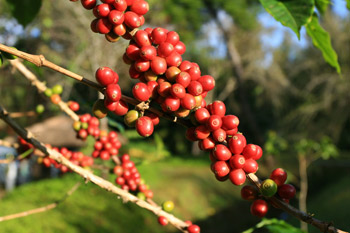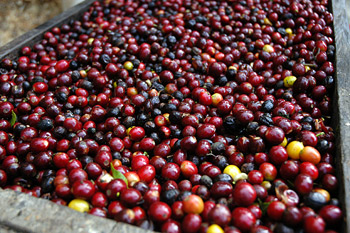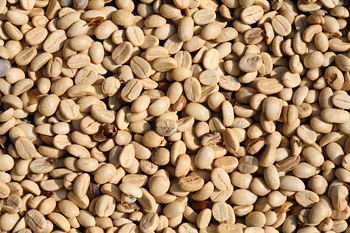 The coffee road The coffee road Cultivation of coffee Cultivation of coffee Arabica coffee Arabica coffee Robusta coffee Robusta coffee Coffee cultivation Coffee cultivation Roasting the coffee Roasting the coffee Tasting and analysis Tasting and analysis Coffee Tasters\' Terminology Coffee Tasters\' Terminology Big producers Big producers Coffee and ecosystem Coffee and ecosystem |
Coffee cultivation
Coffee is cultivated in plantations in over 75 countries around the world. An enormous amount of effort goes into cultivating and harvesting the crop before it reaches the commercial coffee roaster. The entire process lasts a year and includes painstaking processes such as harvesting the ripe fruit and separating the beans from their shells—all of which have an impact on the ultimate quality of the coffee. Harvesting
Harvesting the coffea-cherries in the most appropriate way has its important role in the high quality harvest. Handpicking
In many places where Arabica coffee is cultivated, the pickers carefully select only those fruits which are optimally mature; they handpick them and drop them into baskets. The pickers get paid depending on the weight of the baskets, which can be as heavy as 100 kg. Strip-picking
This method is most often applied in coffee plantations in Brazil. Separating the beans from the fruit pulp
After the cherries have been harvested, the beans must be removed from the fruit pulp. It is very important that the bean is removed from its outer casing and the fruit without being damaged. Two methods are used to accomplish this: Wet processing
Wet processing is usually employed with high quality coffees. Before any fermentation begins, the freshly picked cherries are put in large tanks filled with water. Then the fruit pass through a water channel to soak them and clean of any impurities. The fruit which have not matured yet sink and the ready ones stay on the surface. This way the mature fruit can be further processed.The cherries are carried towards a de-pulping machine. It removes the pulp through water processing. The second stage of the wet processing is the fermentation of the beans in large containers filled with water. The purpose is any remaining mucilage to be broken down by natural enzymes during a 36-hour soak. This mucilage is not water soluble. The long fermentation is the first thing to form the flavor and aroma of the coffee and thus it should be strictly controlled. After the fermentation process is complete, the beans are rinsed and spread out on patios or wire-mesh platforms to dry in the sun. Dry processing
Dry processing also begins with cleaning the newly picked cherries with pressurized air, sieves or water. Once all branches, leaves, rocks and other impurities get removed, drying may begin. In addition, unripe and/or defective cherries float to the surface and can be easily removed. The cherries are then spread out in the open air to dry in the sun for 2-3 weeks and the beans are turned over and raked frequently to ensure that they dry completely. At night and during rainy weather, they are covered to protect them from harm. In arid lands, the beans are sometimes laid out to dry in the sun without being washed first. |


 As an alternative method, especially in large plantations, a special vehicle drives slowly down the row of coffee trees and its revolving arms knock down the looser—and hopefully the riper—fruit off to the ground. Workers then gather the scattered fruit, winnowing it with large meshed hoops, which they use to throw the cherries up in the air to separate them from the twigs, leaves and dust.
As an alternative method, especially in large plantations, a special vehicle drives slowly down the row of coffee trees and its revolving arms knock down the looser—and hopefully the riper—fruit off to the ground. Workers then gather the scattered fruit, winnowing it with large meshed hoops, which they use to throw the cherries up in the air to separate them from the twigs, leaves and dust. To be fully dried their moisture content should be reduced to 11-12%. Drying may take two to three weeks, during which the beans should be turned over several times a day or drying machines should be used. The drying process must be performed correctly in order to preserve the quality of the coffee. Still in their parchment jackets, the beans are stored in special warehouses until transportation. Just before they are sent to the roasters, the beans go through one final process where a machine removes the parchment jacket. The wet method is more expensive than the dry one as it requires much more equipment and is much more labour intensive.
To be fully dried their moisture content should be reduced to 11-12%. Drying may take two to three weeks, during which the beans should be turned over several times a day or drying machines should be used. The drying process must be performed correctly in order to preserve the quality of the coffee. Still in their parchment jackets, the beans are stored in special warehouses until transportation. Just before they are sent to the roasters, the beans go through one final process where a machine removes the parchment jacket. The wet method is more expensive than the dry one as it requires much more equipment and is much more labour intensive.

